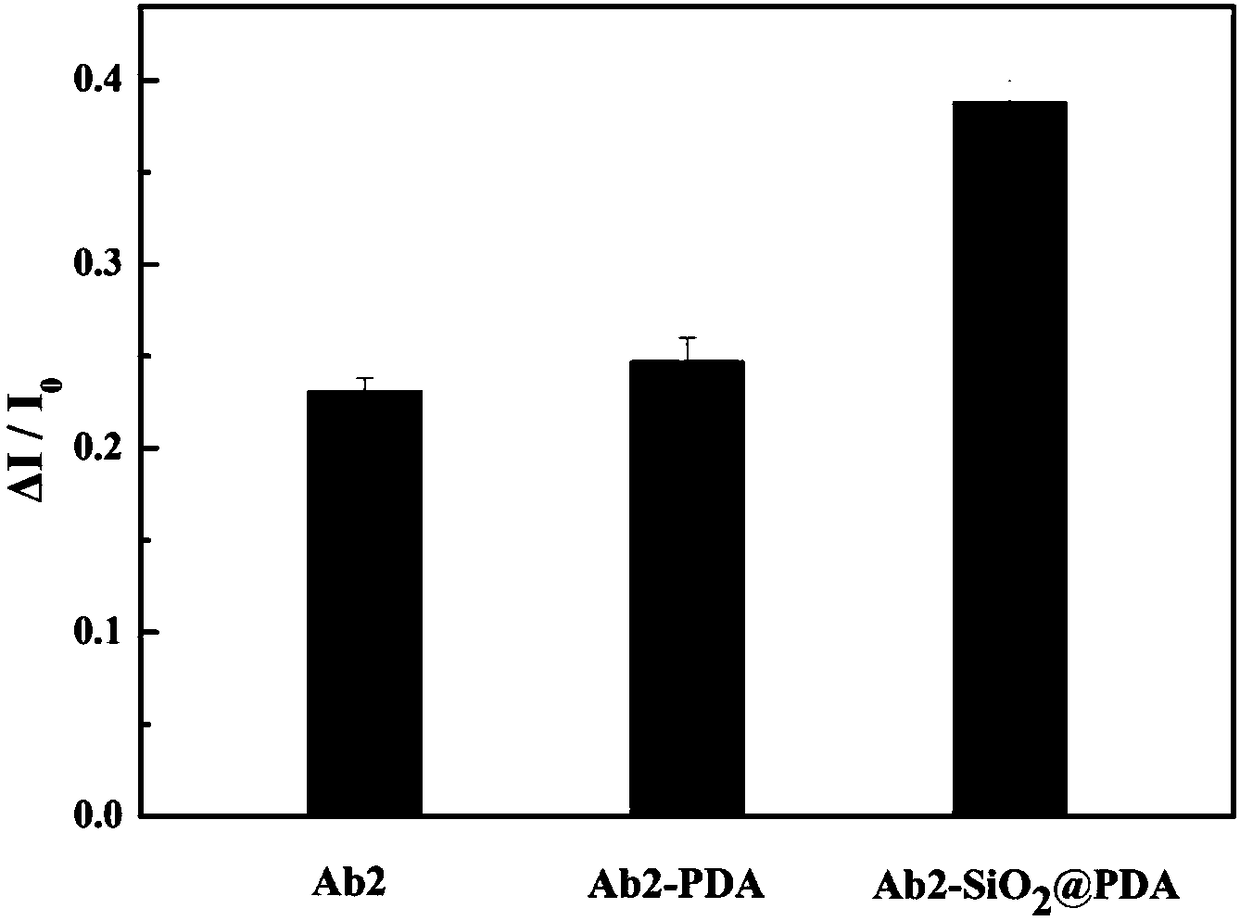Photoelectrochemical immunosensor for detecting CA125, preparation method and application thereof
A CA125, immune sensor technology, applied in the field of biomedical detection, can solve the problems of time-consuming, high cost, low sensitivity, etc., and achieve the effect of simple operation, rapid response, and low technical requirements
- Summary
- Abstract
- Description
- Claims
- Application Information
AI Technical Summary
Problems solved by technology
Method used
Image
Examples
Embodiment 1
[0043] Embodiment 1, quenching agent SiO 2 Preparation of @PDA complex
[0044] (1) SiO 2 Synthesis of nanoparticles: first synthesize SiO with a particle size of about 50nm according to the stober method 2 Nanoparticles, the specific method is: 80mL ethanol, 3.6mL ammonia water, 4.85mL ultrapure water in a single-necked flask, when the temperature rises to 55°C, add a mixture of 3.1mLTEOS and 8mL ethanol, stir for 5h, and obtain a slightly milky white gel solution , washed by centrifugation, and stored in freeze-dry.
[0045] (2) SiO 2 Synthesis of @PDA nanocomposite: then weighed 35mg SiO 2 , 60mg of dopamine hydrochloride and 6mg of Tris were dissolved in 25mL of ultrapure water and stirred for 72h to obtain SiO 2 @PDA nanocomposites.
[0046] (3) Ab 2 -SiO 2 Synthesis of @PDA nanocomplex: 60μL, 100ug / ml Ab 2 (in 0.02M PH=7.4PBS) was added to 400μL 0.1mg / mLSiO 2 Incubate at 4°C for 12h in @PDA (with gentle stirring).
[0047] Then add 1% BSA (dissolved in 0.02M p...
Embodiment 2
[0048] Embodiment 2, the photoelectric activity detection of quencher
[0049] (1) Instrument: Shanghai Chenhua electrochemical workstation (chi660e software), xenon lamp light source, multimeter
[0050] (2) Materials and reagents
[0051] ITO: indium tin oxide semiconductor electrode, the size is 0.4cm×0.4cm
[0052] Electrolyte: 50mM Ascorbic Acid in Phosphate Buffer
[0053] Reagent: Ab 2 , Ab 2 -PDA, Ab 2 -SiO 2 @PDA
[0054] (3) Method: Electrode treatment: place the ITO electrode in acetone, ethanol, and ultrapure water for 20 minutes, blow dry with nitrogen, test the front and back with a multimeter and mark it for later use.
[0055] Dropping sample: Add 5μM CdTe / CS, 1% glutaraldehyde, 10μg / mLAb1, 1% BSA, 10U / mLAg each 10μL dropwise on the electrode surface, then add Ab respectively 2 , Ab 2 -PDA, Ab 2 -SiO 2 @PDA, detection of electrode photocurrent intensity.
[0056] Test: The xenon lamp light source system provides light, and uses the three-electrode s...
Embodiment 3
[0060] Embodiment 3, the preparation method of photoelectric immunosensor
[0061] (1) The signal layer is fixed
[0062] A mixed solution (volume ratio 10:1) of CdTe (5 μM) and CS (0.05 wt %, solvent acetic acid) was added dropwise on the surface of the base electrode ITO by electrostatic adsorption, and placed at room temperature in a dry place for 12 hours to form a film. Dry at 80°C for 2 hours to further strengthen the film, then wash with deionized water and dry to obtain a CdTe / CS / ITO substrate electrode.
[0063] (2) Anchor recognition molecules
[0064] Glutaraldehyde was used as a cross-linking agent to connect Ab 1 with the base electrode. That is, dropwise add a mass fraction of 1% glutaraldehyde solution (the solvent is ultrapure water) to the surface of the base electrode obtained in step (1), leave it at room temperature for 1 hour, and then wash it with deionized water. After cleaning, the recognition molecule 10 μg / ml Ab 1 (The solvent is 0.02M pH=7.4PBS) ...
PUM
| Property | Measurement | Unit |
|---|---|---|
| Particle size | aaaaa | aaaaa |
| Particle size | aaaaa | aaaaa |
Abstract
Description
Claims
Application Information
 Login to View More
Login to View More - Generate Ideas
- Intellectual Property
- Life Sciences
- Materials
- Tech Scout
- Unparalleled Data Quality
- Higher Quality Content
- 60% Fewer Hallucinations
Browse by: Latest US Patents, China's latest patents, Technical Efficacy Thesaurus, Application Domain, Technology Topic, Popular Technical Reports.
© 2025 PatSnap. All rights reserved.Legal|Privacy policy|Modern Slavery Act Transparency Statement|Sitemap|About US| Contact US: help@patsnap.com



